TWIN PEAKS: THE RETURN: The Past Determines The Future
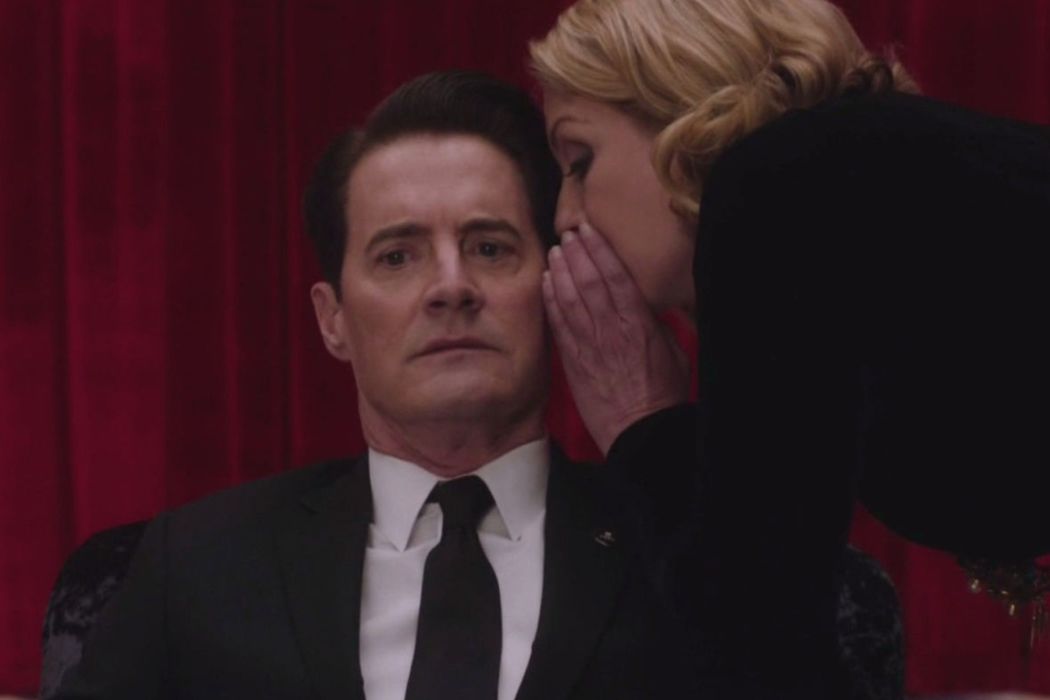
Ben is a former student of cognitive science who is…
We’re quick to call films or other works of art “Lynchian” when they display some especially nightmarish darkness, or an uncanny mix of mystery and magical realism. But when you compare these with David Lynch‘s own work, they rarely evoke quite the same feelings. What’s more, it’s easy to look back at films from before Lynch‘s own time and find work that could just as easily be called “Lynchian”: certain film noir, horror movies, and melodramas all resemble his work as much as current films that draw inspiration from him do – though they similarly fall short of the unique sensibility his films have.
Lynch‘s uniqueness comes from the fact that he borrows freely from many traditions that one wouldn’t expect to complement each other. He takes traits from the emotional frankness of Hollywood dramas and mixes them with elements of surrealism. And within surrealism, he draws on different veins, from the more magical realist inclinations of Jean Cocteau to the camp, rhythmic constructions of Kenneth Anger.
If surrealism is meant to speak to the unconscious mind by imbuing the impossible imagery of dreams with the textures of reality, Lynch can be called a surrealist. But he goes beyond giving dreams the weight of reality: he represents waking life with the intense emotional rawness you might expect from a Vincente Minnelli or Nicholas Ray, to an extent that almost feels artificial. And even putting both these modes of expression aside, we find artifice in other places too. We see it in the dialogue and in certain exaggerated performances in Mulholland Drive, and, of course, Twin Peaks.
Because of its length, format, variety of directors, and perhaps most importantly, the contributions of co-writer Mark Frost, the original Twin Peaks series contains some of the most conventional and some of the strangest material in Lynch‘s body of work. It begins with the murder of a girl named Laura Palmer (Sheryl Lee) in a small Oregon town, and proceeds from that point to explore the town’s hidden currents of crime, domestic abuse, and supernatural forces that interact with them. Even though Twin Peaks at first carries itself like a mystery, we eventually find that it doesn’t aim to reveal truths or solve mysteries: it aims to capture paranoia and ignorance, ways in which people disavow the world in front of them instead of facing it genuinely, in a way that would demand they change themselves.
Now, with Twin Peaks: The Return, we see all of Lynch‘s tendencies come together in what he described as an “18-hour film”. Unlike the original Twin Peaks, every episode of The Return was directed by Lynch, and it has a far greater willingness to abandon normal narrative coherence. It’s among the most experimental of Lynch‘s films, drawing not only on the same influences as the rest, but other avant-garde movements in filmmaking.
The result is a film that Lynch‘s partisans have been overwhelmingly happy about. During its run, they formed countless theories and philosophical interpretations; part of the appeal, after all, is the sense that there must be some meaning that can be teased out of what we see. This is not to say it can’t be enjoyed simply by letting it wash over you: it’s quite good at both humor and horror, and most episodes end with a coda of well-chosen music. But the engaged viewer will probably Twin Peaks more than the passive viewer. Hopefully, by looking at the new things it brings to the table and the effects they have when combined with Lynch‘s other tendencies, we can occasion a more active experience of Twin Peaks for both current and prospective fans.
Rhythm and Reference
In 1970, experimental filmmaker Hollis Frampton released the fascinating Zorns Lemma. It’s a non-narrative film consisting of three parts, each following very strict systems of timing and reference. In the first and third parts, narrators read from texts at a pace of one word per second, resulting in narration that sounds purely mechanical. The second part of the film is the longest and most memorable: it begins with a sequence of 24 shots, each shot lasting one second and depicting a letter of the alphabet. This sequence is repeated over and over, and with each repetition, a letter is replaced with one second of unrelated footage, until the entire alphabet has been replaced with wordless images.
Zorns Lemma works by following a precise rhythm and by referring back to its own images. The result is a process of waiting that engenders a vague sense that you’re looking at something significant. Twin Peaks: The Return does something similar, in a way that the original Twin Peaks didn’t. Conversations play out at a pace that’s just slow enough to be uncomfortable, and events that seem like they should be simple are drawn out. You can feel yourself waiting for the next person to speak, for your expectations to be fulfilled. And they often are; but the pause is enough to arouse some slight suspicions.
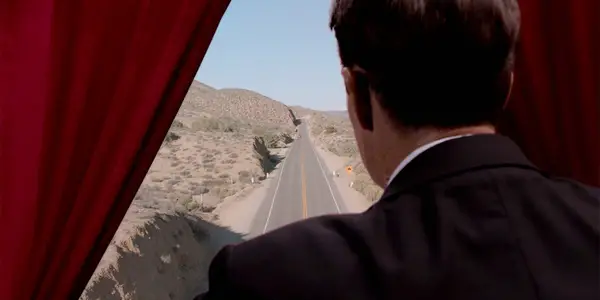
Consider, for instance, Dougie Jones (Kyle MacLachlan). He’s the new incarnation of the original Twin Peaks‘s principal character, FBI agent Dale Cooper. Anyone who’s seen Twin Peaks knows Cooper as one of the most memorable characters for how cheerful and talkative he is. He’s friendly in a way that’s almost off-putting, though the viewer gets used to it (this is something The Return complicates, but more on that later). It’s an excellent performance by MacLachlan. In Twin Peaks: The Return, supernatural forces trap Cooper in the identity of Dougie Jones, an insurance salesman from Las Vegas.
But Dougie is hardly the same character as the Cooper of the original Twin Peaks: he’s a passive, almost catatonic character. He never speaks unless spoken to, and when he does it’s only to repeat the last word that was said. Watching Dougie is an exercise in waiting: we wait for him to repeat things, we wait to see how people react to him, and over the course of the entire show, we wait to get the old Cooper back. This isn’t to say Dougie isn’t entertaining – he makes for good humor, and MacLachlan is still impressive in the role – but there’s always an inclination for something more, a kind of wonder about the future that accompanies his appearances.
There’s also another, more interesting example of how Twin Peaks: The Return asks us to wait while it withholds something: its depiction of Audrey Horne (Sherilyn Fenn). Her first appearance in The Return – something fans of the original Twin Peaks were likely waiting for – occurs without fanfare a little past The Return‘s halfway point. Almost her entire time in the show is spent on one very long argument with her husband Charlie. This argument is divided over multiple episodes, and raises myriad questions for the viewers. The two of them talk about characters we’ve never seen nor heard of. It departs on tangents and starts heading backward whenever it seems to approach a moment of progress or movement.
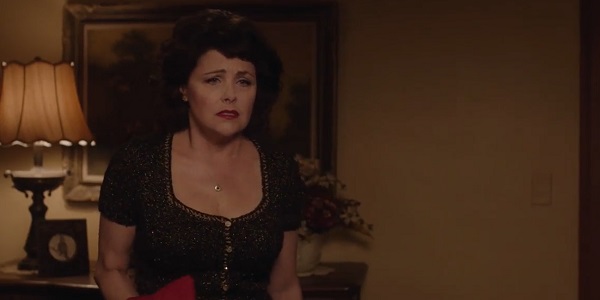
The static nature of Audrey and Charlie’s argument is vexing, and again we find ourselves waiting for something to happen. We wait to hear what the characters have to say in the moment, and to find out if our unanswered questions will be answered in the long run. All the while, Audrey grows more and more upset with their inability to proceed, screaming and often appearing as if she’s close to tears. Charlie remains calm throughout, in an irritating way that suggests he doesn’t care to actually help the situation, or to try to understand Audrey’s agitation.
These scenes mix the rhythmic, reflexive techniques of the rest of the series with melodrama, like a cross between Zorns Lemma and Some Came Running. The result is interesting: these scenes, which contain none of the magical realism or synchronicity of other parts of the show, gain that dreamlike, “Lynchian” quality. The elements of the argument scenes come together to suggest the presence of roiling invisible forces, either unconscious or unspoken. It makes their house feel like a prison. We wait in suspense for the insular world between her and Charlie to finally find a link to the rest of Twin Peaks‘s bizarre, tragic universe that will fill in the space of that missing significance.
Whose Story?
The dialogue in Twin Peaks: The Return poses two questions. They arise during normal discussions carried out by the characters, and are repeated in the penultimate episode under considerably more surreal, unsettling circumstances.
One is a question Audrey asks Charlie, frustrated with his apparent confidence that he knows more about her than she does herself. He starts talking about her “story” in his attempts to counter her frustration with him. She caustically responds: “What story is that, Charlie? Is it the story of the little girl who lives down the lane?”
The other comes in a scene in which FBI director Gordon Cole (played by David Lynch himself) discusses a dream he had. He dreams that Monica Bellucci (as herself) asks him: “We live inside a dream, but who is the dreamer?”
No one would dispute that Twin Peaks: The Return is the story of Laura Palmer, Dale Cooper, and the people of Twin Peaks. But these questions show that The Return is concerned with the fact that its story only represents a finite perspective of the world in which it takes place. Moreover, the characters themselves only represent parts of that finite perspective. When Audrey asks “is it the story of the little girl who lives down the lane?”, it comes with sarcasm and resentment, as a pronouncement against trying to narrow the scope of the world in which Twin Peaks takes place down to a single perspective.
Throughout Twin Peaks: The Return, especially at the ends of episodes, there are brief scenes that interrupt or otherwise diverge from the show’s various plotlines. They feature people who have, apparently, nothing to do with the main characters or any of their concerns. After the scenes are over, we never see them again. We just get little glimpses into their lives, reminders of a world outside that which exists between the main characters.
When Gordon Cole asks “we live inside a dream, but who is the dreamer?”, it’s tempting, in the moment, to say the “dreamer” is David Lynch: he is, after all, the director, and he put those words in his own mouth. But that’s not an adequate answer. We can go all the way back to Eraserhead and see a trend in Lynch‘s work of characters appearing on stage, and key plot points hinging on how main characters react when they see it. The artist is not the only active agent in the Lynchian universe. If detractors accuse Lynch of obscurantism, it might be because he hopes for the audience to be active, to try to make connections and fill in the blanks without being told to.
ELECTRICITY
It’s worth noting that the particularity of perspective is another element of the Lynchian. Twin Peaks is a story of apparently cosmic scale, involving preternatural forces that extend across many lives and immense distances; and yet, the scenes involving these magical elements involve music and décor that speak to a very specific time period and aesthetic inclination. You wouldn’t expect the interior design of the universe itself to so closely resemble the culture represented in films like Sunset Boulevard, and the dissonance that comes from seeing it plays into that Lynchian sense of unease.
On top of the interior design, there’s also technology. Power lines, outlets, film projectors, gramophones, and other pieces of technology are also depicted with a supernatural aspect in Twin Peaks, in a way that engenders a similar dissonance. The supernatural elements of the show are revealed to be ancient, depicted in centuries-old Native American art; what could it possibly have to do with such recent technology?
In the world of Twin Peaks, everything changes with the world and changes it in turn. Even creatures of nightmare adapt to modernity, and we see it in the devices the show’s supernatural villains use to communicate with each other. We also learn about the implicitly technological origins of the villain of the original Twin Peaks, a malevolent spirit called BOB.
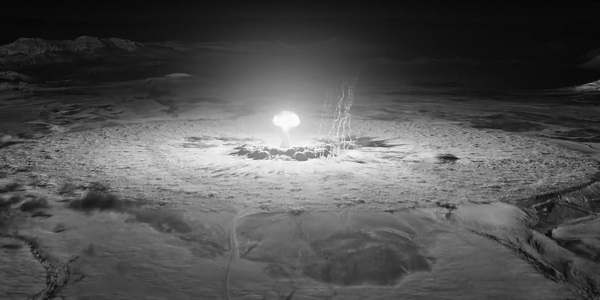
In episode 8, there’s a scene depicting nuclear bomb test in 1946. From here, the episode launches into a lengthy experimental sequence which is both beautiful and terrifying. Flowing colors and close-ups of flames wash over us before disturbing, otherworldly creatures emerge from the chaos and invade the real world, flickering into existence and committing gory murders. BOB is one of these: we see his face emerge from the mouth of a featureless gray person floating in a black void. The implication most people seem to have taken is that BOB originated from how the supernatural layers of Twin Peaks‘s universe reacted to the development of nuclear weapons.
Though most of The Return‘s episode 8 is abstract and unclear – perhaps even non-narrative – we understand one thing quite well: BOB is a force of evil, but not the source of evil. He manifested from technological development which embodied the fear of destruction and warlike resentment. By the end of Twin Peaks: The Return, we cannot blame evil on BOB. It persists without him, in characters who can’t change with the world. Some of them are simply consumed by trauma, others reach for the impossible goal of erasing changes that took place in the past.
Doppelganger!
One of the supernatural elements of the original Twin Peaks was that each character has an evil counterpart, a doppelganger. The doppelgangers reside in a magical location called the Black Lodge, but have the potential to emerge and replace people in the real world. At the beginning of Twin Peaks: The Return, we understand that Dale Cooper has been replaced by his doppelganger, a character often referred to as “Mr. C”. MacLachlan portrays Mr. C as laconic but heartless, capable of killing without a hint of expression. He’s a sort of master criminal. He gains, loses, and disposes of underlings over the course of the show. We understand Mr. C wants to kill Dougie Jones, but other than that, his goals are unclear.
At first, it seems simple. We’re led to think Dougie is the real Cooper and Mr. C is his evil twin. But The Return complicates this understanding. As time goes on without any change in Dougie’s personality (or lack thereof), the question arises of whether he actually is the real Cooper. Also, many scenes suggest that Mr. C is possessed by BOB, which doesn’t seem to make much sense considering that the original Twin Peaks suggested that being possessed by BOB isn’t the same as being replaced by an evil doppelganger.
Here we can return to the point that the Dale Cooper of the original Twin Peaks was friendly, but in a way that’s slightly unsettling. His total lack of hesitation and relentless positivity often seem like heroic traits, but he takes them to an uncanny extent. The original Twin Peaks doesn’t explore this uncanny aspect of Cooper’s personality very much, but The Return does. The Dale Cooper of the original Twin Peaks does eventually make an appearance in The Return, but he has no heroism in him.
In the end, it’s more difficult than the viewer expects to separate Cooper from Mr. C – or even to suppose that they can be separated. Initially, we’re inclined to think Dougie is the real Cooper, but Dougie is a blank slate; Mr. C has a personality, one with all the relentlessness and proactivity of the Cooper depicted in the original Twin Peaks. It’s true that Mr. C isn’t as friendly as the original Cooper, but suffice it to say that the penultimate episode raises some questions about how Cooper really feels toward the people he’s friendly with.
Again, Twin Peaks tends to attract active viewers, people who like to theorize about the physics of its world and what it all might mean. The Return deliberately confuses the physics introduced in the original Twin Peaks, or at least builds on them in a way that drastically alters their moral weight. Twin Peaks no longer takes place in a universe where BOB and evil doppelgangers emerge from another world to intrude on people’s lives. Now it takes place in a universe beyond any one person’s ken, and both BOB and the doppelgangers are effects of the evil done by men who try to force the world to fit in their grasp. It was a little too easy in the original Twin Peaks to view evil as incidental to the supernatural; in Twin Peaks: The Return, it’s the other way around.
Later episodes of The Return borrow footage from the 1992 film Twin Peaks: Fire Walk with Me. That film is possibly even more important to The Return than the original Twin Peaks series is. It establishes that abuse is the central subject of Twin Peaks, setting the stage for The Return’s focus on how evil intersects with the desire to control everything. The show says “we live inside a dream” and never tells us who the dreamer is. There may not even be one; but we know there are some people who try to make themselves the dreamer.
“Beautiful Darkness, with a Soft Wind”
If you take an interpretive approach to Twin Peaks: The Return and look through its bizarre lore and performances for motivations and symbolic meaning, you’ll probably find a painful story. It would be impossible to miss the currents of abuse, of parents losing their children, and of people who feel like less than themselves. It leaves us with little hope, and exposes the 25-year-old naiveté of the original Twin Peaks in its search for heroism.
But if you look at Twin Peaks: The Return in terms of how the viewer actually experiences it, you find it’s not all so dark. When it goes for humor, it does quite well, and sometimes it’s even uplifting, in a few very brief scenes that resolve some of the show’s subplots. The more puzzling parts have an aesthetically satisfying sense to them, whether it’s because they make for good horror or just because there’s something pleasing about the way the images overlap and flow.
Part of the way Twin Peaks: The Return addresses evil is to name it, to take away the idea that the characters’ actions aren’t their own. But there’s still a reason its magical realism confounds our notions of the characters’ identities. At one point, we see a character who’s suffered: Diane (Laura Dern), Cooper’s former assistant. In the middle of an emotional breakdown, she utters the phrase “I’m not me”; Audrey complains of a similar feeling in her argument with Charlie. The characters’ actions in Twin Peaks: The Return are their own, but the show also suggests that you can’t fully be yourself if you’ve come to totally hate the world, because you’re part of it. At the same time, it knows there are some serious reasons people end up in that position.
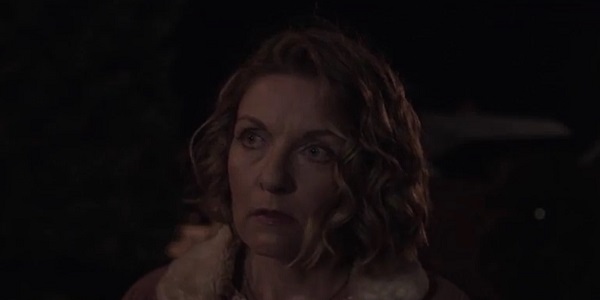
Late in the series, we see Laura Palmer, the character who’s suffered the most and knows things aren’t going to get better. In this scene, we understand the depths of her despair, but we also find out that there are still things in her life that she loves. To reject the present is to reject the past, and Laura has the darkest past of all the characters; but she still embraces something about the present.
Some of the most satisfying parts of Twin Peaks: The Return are musical, including the band performances at the end of each episode and the moments when Angelo Badalamenti‘s score is allowed to take over a scene. There usually isn’t much happening in these moments. We intuit, from the show’s other quirks, that the bands on stage have their own stories, but we don’t know anything about them. These are times at which there’s nothing to explain and nothing to wait for, times to embrace something in the present without any reason to want to control it.
According to Badalamenti, when he composed “Laura Palmer’s Theme” – Twin Peaks‘s signature piece of music – David Lynch asked him to imagine the woods at night, in a “beautiful darkness, with a soft wind”. Then, to imagine Laura Palmer emerging from the woods, to imagine a scene that was still beautiful, but “very sad”. The result is a song of mixed emotional tones that flow into each other seamlessly, and plays at all different kinds of moments throughout the many iterations of Twin Peaks. Sometimes it’s peaceful, sometimes it’s ominous, sometimes it’s tragic.
That is Twin Peaks: a dark place filled with forces beyond anyone’s control, and people who’ve suffered unimaginably. So much so, in fact, that it can’t really be called beautiful; and considering how The Return went, it wouldn’t surprise me to learn Lynch or Frost eventually started to think the same in the 25 years between the original Twin Peaks and now. The only way to redress the trauma is to name it, not to pretend there’s beauty where there is none. Nevertheless, at the same time, looking at the uncontrollable and finding something to accept is the only way to move on in a world where the past determines the present and the future.
Do you prefer to theorize about Twin Peaks and similar films, or do you prefer to experience them in a less interpretive way?
Twin Peaks: The Return began May 21, 2017 and ended September 3, 2017. It’s currently available for streaming through Showtime.
https://youtu.be/vsdRG0mJj-w
Does content like this matter to you?
Become a Member and support film journalism. Unlock access to all of Film Inquiry`s great articles. Join a community of like-minded readers who are passionate about cinema - get access to our private members Network, give back to independent filmmakers, and more.
Ben is a former student of cognitive science who is currently trying to improve his writing style and ability to understand and appreciate films containing unfamiliar perspectives. He tries not to hold films to a strict set of criteria, but does believe that strong movies can change your outlook on the world. His favorite films include Whisper of the Heart, Hellzapoppin', Foolish Wives, 42nd Street, and the work of Charlie Chaplin.












